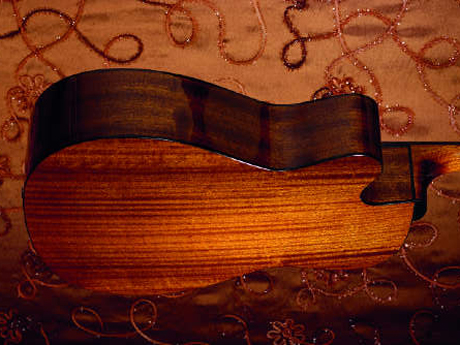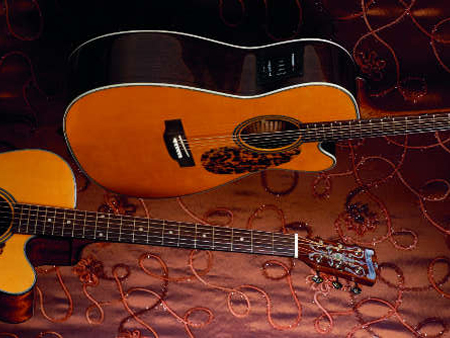MusicRadar Verdict
A guitar with quality - whether of construction, finishing, handling, sound or vintage-evoking elegance - to compete at any level.
Pros
- +
Pretty much everything.
Cons
- -
String path is a visual muddle on narrow headstock, but no ill effects on performance.
MusicRadar's got your back
Blueridge guitars, in particular the all-solid wood Historic and Prewar series, have attracted much praise over the years. This hasn't been just for sound quality and the instruments' vintage-Americana aesthetics, but also because their high-grade specifications are offered at sensibly affordable prices courtesy of Chinese manufacture.
Hallmark cosmetics like amber-tint tops, 'dalmatian' pickguards and elaborate pearl-inlaid pegheads also help make the Historics and Prewars distinctive parts of the Blueridge catalogue. Until recently Blueridge's line-up - based almost entirely on dreadnought and 000 designs - was a wholly acoustic one. Now, however, a few selected models are being added as electro-acoustics, including this Historic series cutaway 000.
The official website specifies a Fishman Prefi x Plus system but our sample carries the cheaper Classic 4 preamp. Nothing wrong with that - it's a straightforward, dependable system.
Build
Apart from installing the electrics, Blueridge has essentially taken its regular BR143 folk and fashioned in a Venetian cutaway for full access to the 20-fret fingerboard.

The back and sides of this 15-inch wide instrument are solid mahogany and are stained, along with the mahogany neck, to a deepish brown prior to lacquering. The solid Sitka spruce top - an excellent-looking example with close graining and richly cross-silked - carries a vivid amber tint, or 'aged toner' as the company likes to call it.
One or two Blueridge tops we've seen have frankly been too perma-tanned in colouring, but this one stops short of that while still endowing a rich vintage-like aura. Buffing of the gloss finish is immaculate.
Part of the Historic theme lies hidden, the top being strutted with prewar-style, forward-shifted X bracing. This might be a nod towards traditional authenticity, but it's also a mite ironic since Martin, for example, moved its further back in 1940 to compensate for the stress of the heavier-gauge strings then starting to be favoured by players. Never mind: it's all neatly done, and scalloped by hand, apparently.
The most obvious blast from the past is the pearl and abalone-swathed headstock, reminiscent of the kind of inlay finery you'd increasingly have seen on guitars during the early part of the last century. The complex floral/urn motif is stunning, and it must be thanks to laser-cutting technology that such decoration can be included on a guitar of this price.
It sits beautifully on the compact peghead - and so do the open-geared Grover 'Sta-tite' machineheads - but there is a design drawback hereabouts. Because of the headstock's petite narrowness, the string path is constricted, to the extent that the B and A strings are actually touching the posts of the top and bottom E tuners as they pass. Happily, this situation doesn't cause any tuning problems, but it does look muddled.
On a retro-inspired acoustic you might expect a quite chunky, broad neck, but Blueridge bows to modern mainstream sensibilities with one that's not only of regular width but also has a distinctly shallow profile starting at under 20mm deep.
Coupled with well-dressed fretting it's a delightfully slick player as a result, especially for those of us with smaller hands, and the only potential buyers who might demur from that opinion are those specifically looking for something with a more substantial, overtly vintage grip.
Some fingerstylists might wish for slightly wider string spacing at the bridge than the 53.5mm has on offer, but in truth the guitar is a perfectly obliging picker, in the Yamaha/Takamine mould. Linked to a Fishman Acoustic Matrix under-saddle pickup, the Classic 4 preamp is conveniently mounted forward of the waist and provides a simple, all-slider array embracing four-band EQ and volume.
The control panel can be unlatched for a quick battery change.
Sounds
Though it doesn't have a large or especially deep body, the BR143CE delivers an amazingly responsive sound. In sheer acoustic volume it's louder than most folk size guitars you'll come across - certainly at this price - and it's coupled with a springy yet crisply-defined voicing and a degree of warmth and depth from the low end that is surprisingly, and rewardingly, robust.
Some originally non-cutaway designs suffer from acquiring a cutaway, but not this one. In auditorium terms it's a little belter. No worries when plugged in, either. The Classic 4 takes to its task effortlessly, providing a versatile tonal palette, plenty of gain (and a wellbalanced piezo output), and all the while retaining the guitar's acoustic zest and clarity.
A modicum of care needs to be taken with treble and brilliance not to let the top end assume a brittle edge but, having allowed for that, the quality of powered performance is right on the money.
“A synthesizer that is both easy to use and fun to play whilst maintaining a decent degree of programming depth and flexibility”: PWM Mantis review
“I feel like that song had everything we needed to come back with”: Bring Me The Horizon’s Lee Malia on Shadow Moses, its riff and the secrets behind its tone, and why it was the right anthem at the right time
“I said, ‘Are we sure we can write a song about death?’”: The story of Mike + The Mechanics' classic No.1 The Living Years










